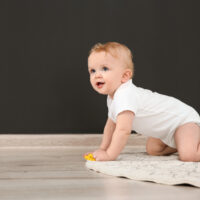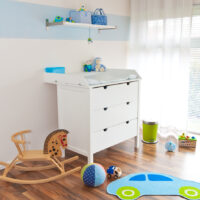If you are wondering how to use a baby wrap, I’ve got you covered with the basics. With just a little bit of know-how and a whole lot of practice, you can turn that long length of fabric into a bonafide baby carrier.
Here’s how to do the three most popular baby wrap carries. I will also cover how to use a wrap safely and why you should consider babywearing.
How to Do a Pocket Cross Carry Wrap
While there are many ways to tie your favorite baby wrap, I will first discuss the pocket cross carry, which is great for newborns and smaller infants, though it can be used for bigger babies.
1. Place the wrap properly
First, you will need to find the center of the wrap, which usually has a tag or other marking on it to make it easy to find. Place the center of the wrap on your upper chest with the fabric spread out flat.
Then, bring the ends behind you to form a flat X on your back. You will bring the ends of the wrap up over each shoulder. Make sure they are spread out flat, not all bunched up.
2. Create the “seat”
Now you have the center panel across your torso and two tails. Take the two tails and thread them through the center panel. Pull them tight to remove all slack so that the wrap is very form-fitting. It shouldn’t restrict your breathing, but it should be snug.
Take the tails and cross them where you want your baby to sit. This should be at belly-button height or higher for small babies.
Then pull the ends of the crossed tails behind you. Make sure they are tight and tie them off. Depending on your size and your wrap’s size, you may tie them behind your back here or wrap them around again to the front. Tighten the ends and knot them.
Check again that the wrap is snugly around you while still allowing you to move your arms. Now you are ready to put your baby in the wrap.
3. Place your baby
To place your baby in the wrap facing you, pull the center panel down to expose more of the fabric that’s crossing your torso. Hold your baby high on one shoulder while you stretch out the innermost piece of fabric.
You will stretch this fabric around your child’s leg, from knee to knee. This should support him, but keep holding on. Then shift him to the other shoulder to stretch the other crossed piece of fabric over your baby.
Next, you will pull the center panel back up so it goes from baby’s bottom up to the back of his neck. This should make him very snug inside the wrap so he can’t move too much.
Forward-Facing Carry
If your child is older and has full head and neck control, you may want to try a forward-facing carry for short periods of time. To do this, tie the wrap around you as shared above. But when you go to place your baby in the wrap, hold her facing outward.
Insert one of her legs under one of the crossed pieces of fabric. Keep a good hold on her as you do this. As you continue to support her, shift her to the other side and slide her leg under the other crossed piece of fabric. This will make an X of fabric under her bottom.
Spread out the fabric beneath her to make a secure seat and move her knees into an M position. If you want to leave her hands free, leave the fabric more together over her shoulders. If you want her arms more contained, you can spread the fabric out from her shoulders.
Check that your baby’s knees are positioned well. You don’t want her legs to dangle. Then pull the center panel up over your baby’s legs to her armpits.
Though your older baby may like facing forward, it is best to do it only for short periods. Your body behind your child will push her spine into a curve that isn’t natural. It can be harder to keep your baby’s legs in the good M position in this carry. It is also harder on your back to carry a baby this way. So it shouldn’t be used too often.
4. Remove your baby
You don’t have to untie the wrap to get your baby out. Just pull down the center panel, while giving support with one hand. Then pull off one cross piece of fabric and then the other.
You can keep the wrap on to put your baby back into later. Just be sure to check for tightness and maybe retie the knot before placing your baby back in case the wrap loosens.
How to Do a Hip Hold Wrap
A hip hold will be appropriate for older infants and toddlers.
1. Place the wrap properly
First, you will need to find the center of the wrap, which usually has a tag or other marking on it to make it easy to find. Place the center of the wrap on your upper chest with the fabric spread out flat.
Then, bring the ends behind you to form a flat X on your back. You will bring the ends of the wrap up over each shoulder. Make sure they are spread out flat, not all bunched up.
2. Create the “seat”
Now you have the center panel across your torso and two tails. Take the two tails and thread them through the center panel. Pull them tight to remove all slack so that the wrap is very form-fitting. It shouldn’t restrict your breathing, but it should be snug.
Take the tails and cross them where you want your baby to sit. This should be at belly-button height or higher for small babies.
Then pull the ends of the crossed tails behind you. Make sure they are tight and tie them off. Depending on your size and your wrap’s size, you may tie them behind your back here or wrap them around again to the front. Tighten the ends and knot them.
Check again that the wrap is snugly around you while still allowing you to move your arms. Now you are ready to put your baby in the wrap.
3. Place your baby
Pull out the crosspiece of fabric from the opposite side of the hip you will want your child on. Stretch it around your child, while he faces you, on the side you will carry him on.
Bring him back to the center to ensure both cross pieces of fabric are under him. Then shift him back to the desired hip and pull the center panel up from his bottom up to the back of his neck.
Make sure your child is upright and you can see and kiss his face.
To remove your child, reverse the steps while supporting him with one hand.
How to Do a Kangaroo Hold Wrap
1. Place the wrap properly
First, you will need to find the center of the wrap, which usually has a tag or other marking on it to make it easy to find. Place the center of the wrap on your upper chest with the fabric spread out flat.
Then, bring the ends behind you to form a flat X on your back. You will bring the ends of the wrap up over each shoulder. Make sure they are spread out flat, not all bunched up.
2. Create the “seat” and place your baby
You should have a center panel across your torso and two tail ends over your shoulders. Place your baby into the center panel while she faces you, supporting her head and bottom.
While continuing to support her underneath, pull one tail of fabric under her and around your back. Then pull the other side’s tail under her and around your back. Bring the tails around to your front and knot them under your baby.
Be sure your baby’s face is in the open space between the cross pieces of fabric and not pressed into your chest. Check that her knees are up more than her bottom, forming an M. Do not let her slide down into the pouch of fabric over your stomach.
How to Use a Baby Wrap Safely
The American Academy of Pediatrics does recommend babywearing, but there are some tips to keep in mind to keep your child safe.
- Check with your child’s doctor about baby-wearing. Some babies who have been in the NICU may not be strong enough to breathe well in an upright position.
- Always be sure baby’s face is uncovered so she can breathe while in a wrap or sling. Baby’s chin should not be touching her chest either, to keep airways open.
- You should be able to see your baby’s face at all times, and he should be close enough to your chin that you can kiss his head at any time.
- Your baby’s neck and back should be supported. For young babies, it is best if their knees are higher than their bottoms while being worn, so their legs make an M shape.
- Make sure also that your activities while baby-wearing are safe for your baby to be around. Be wary of using sharp or hot items close to your baby. Being too active may affect the snugness of the wrap. Bending too far over can also be unsafe.
- Also, be aware of the weight limit of your wrap to ensure your child is in the safe range.
Why You Should Use a Baby Wrap
There are many benefits of baby-wearing. The AAP says that it is a good way to respond to a crying baby. It also helps prevent crying as your child remains close to you.
The time spent together promotes a healthy bond between you and your child. The proximity to your heartbeat, scent, and warmth are also comforting for your child.
While you probably love to hold your baby, which also gives those benefits, there are times you also need to have your hands free to do other things. Using a baby wrap is a great way to give your baby the closeness they want while giving you the freedom to tend to other children, do light housework, or take a walk, for example.
The benefits of baby-wearing are noted by many other experts and organizations, including La Leche League and Dr. Sears.
Babywearing Wrap Up
If you are ready to give babywearing a try, here are our favorite baby wraps.
But wraps aren’t the only way to wear your baby safely. Check out the best ring slings and an in-depth comparison of two top baby carriers for other baby-wearing ideas.







